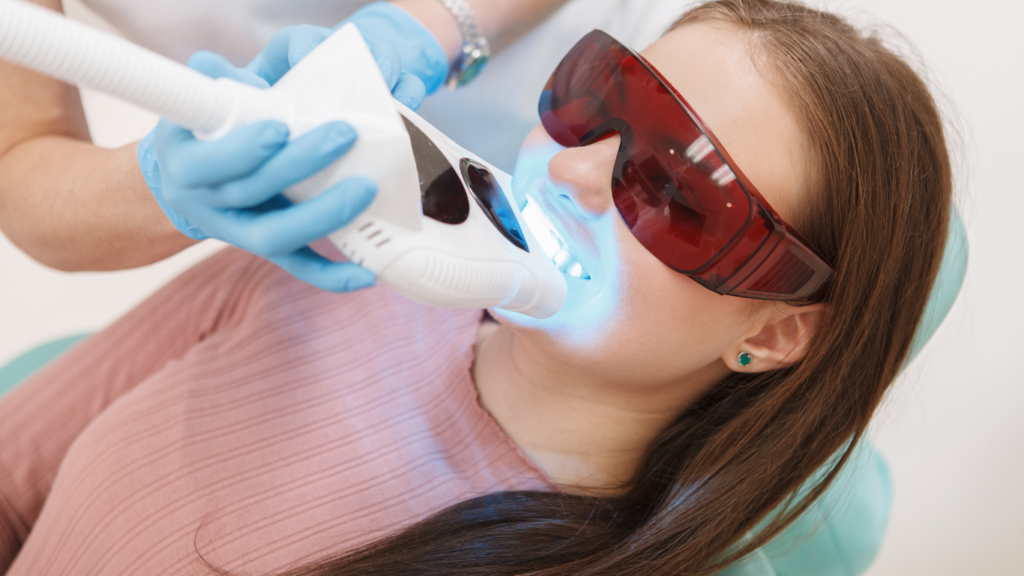A radiant, white smile has the power to boost confidence and leave a lasting impression.
While teeth whitening is one of the most popular dental procedures, but it is also one of the least understood!
As the pursuit of a brighter smile becomes increasingly popular, understanding the art and science behind teeth whitening is essential for making informed decisions about your oral health.
In this article, we’ll delve into the intricacies of this cosmetic dental procedure.
The Basics of Teeth Whitening
Attempts to find an effective teeth whitening method have been made throughout the history of dentistry. Early studies reported the combination use of pyrozone 25% and electricity to whiten endodontically treated teeth.
The early attempts to whiten teeth were based on the assumption that the process involved the removal of extrinsic enamel stain; the mechanism of action was poorly understood, to say the least.
Fortunately, we’ve come a long way in cosmetic dentistry since then!
The Science Behind Teeth Stains
To comprehend the science of teeth whitening, it’s crucial to understand the two types of tooth stains: extrinsic and intrinsic.
Extrinsic Stains
Extrinsic stains affect the outer layer of the tooth (enamel) and are often caused by external factors such as coffee, tea, red wine, and tobacco. These stains respond well to surface teeth whitening treatments.
Intrinsic Stains
Intrinsic stains, on the other hand, occur within the tooth’s structure (dentin) and may result from factors like trauma, certain medications, or excessive fluoride during tooth development.
Various systemic conditions can also cause tooth discolorations. Amelogenesis imperfecta may result in hypoplasia or hypocalcification with yellow or brown stains, and dentinogenesis imperfecta may result in brownish-violet, yellowish, or gray discolorations
Intrinsic stains can be more challenging to address and may require alternative whitening methods.
Teeth Whitening Methods
Dentists offer various teeth whitening methods tailored to individual needs. Here are some common approaches:
In-Office Teeth Whitening
Professional, in-office teeth whitening involves the application of a high-concentration whitening gel by a qualified dentist.
The process is accelerated using a special light or laser. This method provides quick and noticeable results in just one visit!

At-Home Whitening Kits
While at-home kits offer convenience and flexibility, they are oftentimes less than ideal because the trays are not custom-fitted and the formulation is often not as sophisticated as those used by dentists.
Another point to note is that if you use an OTC teeth whitening product during dental treatment, it could affect final color matching by the dentist and/or the dentist’s ability to bond to recently whitened teeth.
Whitening Toothpaste and Rinses
Over-the-counter whitening toothpaste and rinses are marketed as a means to remove surface stains. However, only a small number of them show stain removal ability and effectiveness.
Most of these toothpastes do not contain whitening agents in their ingredients. The ones that do have a very low bleach concentration and the contact time is too short to be effective.
Lifestyle Changes
Adopting good oral hygiene practices, reducing the consumption of stain-causing foods and beverages, and quitting smoking can contribute to maintaining a whiter smile, reducing the need for frequent teeth whitening.
Natural teeth whitening
There are many homemade teeth whitening remedies available on the internet. However, we caution against using such homemade whitening pastes, as they can cause permanent and irreversible damage to your teeth.
One strategy is to prevent extrinsic stains by using a straw to consume drinks that contain tannins, pigments or high acidic content, such as coffee and red wine.
Dental Veneers
While not technically a teeth whitening procedure, veneers are a different means to the same end.
Porcelain veneers are thin, tooth-coloured, custom-made shells that cover the front surface of your teeth, and are a popular option for very extreme cases of multiple chipped teeth or intense discoloration that cannot be lightened by other methods.
They are used to improve dental appearance and function by covering up stains or other imperfections on tooth surfaces. One tooth or multiple teeth may undergo veneering at the same time.
The Art of Smile Enhancement
Teeth whitening is not just a scientific process; it’s also an art!
Skilled dentists consider factors such as facial features, skin tone, and personal preferences when recommending the ideal shade of white for your teeth.
Striking the right balance ensures a natural-looking, enhanced smile that complements your overall appearance.
Considerations and Precautions
Before embarking on a teeth whitening journey, it’s essential to consult with a dentist well-versed in cosmetic dentistry. They can assess your oral health, identify the type of stains you have, and recommend the most suitable whitening method.
It’s crucial to understand that teeth whitening may not be suitable for everyone, particularly those with certain dental conditions or restorations.
Possible side effects are temporary teeth sensitivity or a minor dull ache. It is advised to avoid very hot or cold drinks for the first 24 hours if there is any sensitivity and apply the desensitizing gel provided in the take-home whitening kit.
Other common but short-lived side effects caused by the whitening ingredients include gum sensitivity, mouth ulcers and sore throat, though these should go away quickly.
If you have any concerns regarding the side effects of teeth whitening, speak to your dentist during your initial consultation!

Maintaining Your Bright Smile
After achieving your desired level of whiteness, maintaining good oral hygiene practices and scheduling regular dental check-ups are vital. Avoiding stain-causing habits and periodic touch-ups, as recommended by your dentist, can help extend the longevity of a sparkling smile!
By understanding the underlying science and consulting with a qualified dentist, you can embark on a teeth whitening journey that not only brightens your smile but also promotes optimal oral health.
Modern Day Dental – Teeth Whitening St. Johns, Florida
At Modern Day Dental, our professional whitening treatments quickly and safely remove stains without damaging your teeth. We’ve seen countless patients grow in confidence thanks to a brighter, whiter smile.
Ask us about whitening to see if you may be a good candidate!

